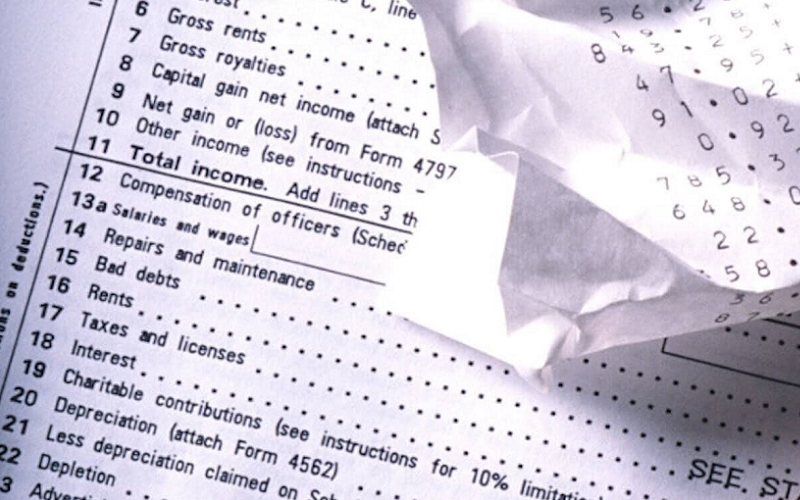
In the realm of entrepreneurship, the Limited Liability Company (LLC) stands out as a popular choice for many business owners. Its blend of flexibility, asset protection, and tax benefits make it a compelling structure for various enterprises. Yet, while many are aware of the advantages, understanding the tax implications, especially when the business incurs losses, remains clouded in confusion. As it turns out, these LLC losses can significantly impact your personal tax situation. Here we examine the intricacies of how such losses flow through to your personal taxes and what they mean for your financial landscape.
Contents
Introduction to LLC Taxation Structure
In the bustling world of entrepreneurship, the Limited Liability Company (LLC) is often hailed as the structure of choice for many who embark on a business journey. With its unique blend of operational flexibility, protection from personal liability, and often favorable tax treatment, it’s no wonder that countless startups and established businesses opt for the LLC. However, amidst all the benefits, there’s one area that remains a common gray area for many: the tax implications of an LLC, particularly when the business undergoes financial turbulence and incurs losses.
Definition of an LLC
An LLC, or Limited Liability Company, is a hybrid business entity that amalgamates the features of both partnerships and corporations. Owners of an LLC are referred to as members, and they can be individuals, corporations, or even other LLCs. The primary allure of an LLC is that it offers its members protection from personal liability, which typically means that members are not personally responsible for business debts and liabilities.
Overview of LLC Taxation Structure
At its core, an LLC is recognized as a “pass-through” entity for tax purposes. This essentially means that, instead of the business itself paying taxes, the profits and losses of the LLC “pass through” to its members. These members then report their share of the profits and losses on their individual tax returns. It’s worth noting that an LLC can also opt to be taxed like a corporation, but for the context of this post, we’ll focus on the default pass-through designation.
Importance of Understanding the Implications of LLC Losses on Personal Taxes
When an LLC is in the black, members usually enjoy their share of the profits and account for them on their personal tax returns. But what happens when the tables turn and the business faces financial setbacks? Losses from an LLC can be both a boon and a bane. On one hand, they can potentially offset other income, reducing your overall tax liability. On the other hand, there are rules and limitations that dictate just how much of these losses you can deduct. Being armed with knowledge about these nuances is indispensable. Not only can it influence business decisions, but it can also optimize the way you navigate your personal tax situation.

Understanding Pass-Through Taxation
While the LLC’s unique hybrid structure offers a blend of both corporate and partnership characteristics, its tax implications are distinct and need careful navigation. The bedrock of LLC taxation lies in its pass-through nature. To truly grasp how losses can affect your personal taxes, one must first comprehend the foundational elements of pass-through taxation.
Explanation of Pass-Through Entities
Pass-through entities, as the name suggests, act as financial conduits. Instead of these entities paying federal income taxes, their profits and losses “pass through” to the owners. This eliminates the double taxation often seen with traditional corporations—where a corporation pays tax on its profits and then shareholders pay tax again when receiving dividends. For LLCs, members report their allocated shares of profits and losses directly on their personal tax returns [1].
How the IRS Views LLC Income and Losses
To the IRS, an LLC’s financial activity is synonymous with its members’ individual activities, assuming the default tax classification. When an LLC earns money, it is treated as if its members earned it directly. Conversely, when the LLC incurs a loss, it’s treated as though the members individually faced that loss. This means that, in theory, an LLC member can use their share of the business loss to offset other personal income. However, while this seems straightforward, complexities arise from various rules that may limit this ability, which we’ll explore in subsequent sections.
Difference Between Pass-Through Taxation and Corporate Taxation
It’s pivotal to understand how pass-through taxation contrasts with corporate taxation. In a traditional corporation, also known as a C-corporation, the company itself pays corporate income tax on its profits. Once these profits are distributed to shareholders as dividends, they’re taxed again at the shareholder’s individual tax rate. This leads to the aforementioned ‘double taxation.’
In contrast, with pass-through entities like LLCs, this double taxation is sidestepped. The profits and losses of the business are only taxed once, at the individual member’s rate. While this often offers a favorable tax outcome, especially when the LLC is profitable, it also means members directly feel the impact of any business losses on their personal tax situation. This direct link between business performance and personal taxation underscores the importance of being well-versed in how LLC losses can affect your individual tax liability.

How LLC Losses Impact Member Taxation
An inevitable aspect of any business’s journey is facing financial highs and lows. While the highs are celebrated, the lows can often bring about concerns, especially regarding how they reflect on individual tax liabilities for LLC members. In the realm of pass-through entities, it’s crucial to comprehend how these financial downturns directly influence each member.
Allocated Losses Based on Ownership Percentage
Losses in an LLC are usually not shared equally among members unless the operating agreement specifies otherwise. Instead, they’re typically allocated based on each member’s ownership percentage. For instance, if an LLC incurs a loss of $10,000 in a year and a member owns 30% of the LLC, that member would report a $3,000 loss on their personal tax return. This allocation process is pivotal because it affects each member’s personal tax situation differently, depending on their ownership stake and the LLC’s financial performance [2].
Decreasing Taxable Income
One silver lining when an LLC incurs losses is the potential tax relief for its members. As these losses flow through to members’ personal tax returns, they can offset other sources of income. For example, if an individual has $70,000 in income from other sources and a $20,000 allocated loss from an LLC they are a part of, their taxable income could be reduced to $50,000. In essence, the loss could act as a cushion, softening the blow of a challenging financial year for the business by providing members with a reduced tax burden.
Potential Limitations on Deducting Business Losses
While the prospect of reducing taxable income through LLC losses sounds promising, there are caveats. The IRS has set up specific rules and limitations to ensure that these deductions are legitimate and not merely strategic tax maneuvers. Three major limitations come into play:
- The basis limitation ensures members can’t deduct losses that exceed their investment in the LLC.
- The at-risk rules dictate that members can’t deduct losses beyond what they’ve personally risked in the business.
- Passive activity loss rules might limit deductions if members aren’t actively participating in the business.

How to Report LLC Losses on Personal Taxes
Navigating the maze of taxation can often be daunting. However, understanding the proper channels and procedures can simplify the process immensely. When it comes to reporting LLC losses on your personal taxes, the method hinges largely on the structure of the LLC and your role within it.
Using Schedule C for Sole Proprietors or Single-Member LLCs
If you’re the sole member of an LLC, the IRS treats your business as a disregarded entity for tax purposes, essentially equating it to a sole proprietorship. In this scenario, you’d report your business’s income and losses on Schedule C (Profit or Loss from Business) of your individual tax return.
- Recording Business Income: Start by detailing your business’s gross receipts and sales. This provides a clear snapshot of your revenue.
- Deducting Business Expenses: List out all your allowable business expenses. This includes everything from office supplies to rent, advertising, and more.
- Calculating Net Profit or Loss: Subtract your expenses from your income. If expenses exceed income, you have a net loss, which you’ll report on line 31 of Schedule C.
This loss can then offset other forms of income on your tax return, potentially reducing your overall tax liability.
Using Schedule E for Multi-Member LLCs
For multi-member LLCs, the default classification is as a partnership. In this case, losses and income flow through to each member. The LLC itself files an informational return using Form 1065, and each member receives a Schedule K-1 delineating their share of the income or loss [3].
Members then report their share of the partnership’s income or loss on Schedule E (Supplemental Income and Loss) of their personal tax return.
- Part I of Schedule E: Here, you’ll list out rental real estate and royalties, which may not always apply.
- Part II of Schedule E: This is where you record income or losses from partnerships. Your share of the LLC’s loss, as reported on your Schedule K-1, will be entered here.
It’s crucial to accurately transcribe the values from your K-1 to ensure the correct loss amount offsets your other income.
Importance of Form K-1 for Partnerships
Form K-1 is a linchpin in the tax reporting process for members of multi-member LLCs. It not only informs each member of their allocated share of the profits and losses but also provides crucial details on distributions, capital account changes, and other vital financial information. Each member’s K-1 might vary based on their ownership percentage, contributions, and any special allocations outlined in the LLC’s operating agreement. Members must wait to receive their K-1 before they can complete their personal tax returns, emphasizing the importance of the LLC preparing and distributing these forms promptly.
The Concept of Basis in an LLC
The notion of “basis” in the context of an LLC is one of the most pivotal yet often misunderstood elements of tax law. It forms the backbone for determining how much of the LLC’s losses a member can deduct on their personal tax returns. To truly grasp the implications of LLC losses on personal taxes, an in-depth understanding of basis is paramount.
Definition and Significance of Basis
At its core, basis represents a member’s investment in the LLC. It’s a way to measure how much capital or property a member has put into the business and how much they’ve taken out, either as distributions or deductible losses. This value isn’t stagnant; it changes as the business operations proceed, either increasing with additional contributions and allocated profits or decreasing with distributions and allocated losses [4].
The significance of basis can’t be understated. It directly influences the amount of loss a member can claim on their tax return. If a member’s share of the LLC’s loss exceeds their basis, they can’t deduct the entire loss in the current year. Instead, they’ll have to carry it forward to a subsequent year when they have enough basis to absorb it.
Calculating Your Basis
Determining your basis in an LLC involves a few steps:
- Initial Investment: Begin with your initial contribution to the LLC when you became a member. This includes both cash and the fair market value of any property you contributed.
- Adjustments for Profits and Losses: Each year, adjust your basis by your share of the LLC’s profits or losses. Profits increase your basis, while losses decrease it.
- Adjustments for Distributions: If you receive distributions from the LLC, subtract them from your basis.
- Adjustments for Additional Contributions: If you contribute more funds or property to the LLC, increase your basis by the amount or the fair market value of the property.
Remember, loans made to the LLC don’t usually increase a member’s basis unless the member is personally liable for repayment.
Impact on Loss Deductions
Your basis in the LLC dictates how much of your share of the business’s losses you can deduct. If you have a sufficient basis, you can generally deduct your entire allocated loss for the year. However, if your share of the loss exceeds your basis, you’ll be limited [5].
For instance, if your basis is $5,000 and your share of the LLC’s loss for the year is $7,000, you can only deduct $5,000. The remaining $2,000 loss is carried forward to the next year. You’ll be able to deduct it in a future year when you have sufficient basis.
In essence, while basis can seem like a convoluted concept, it’s the key to unlocking the full tax-saving potential of LLC losses. By maintaining a meticulous record of contributions, distributions, and your share of the LLC’s profits and losses, you can ensure you’re optimizing your tax position year after year.
References
[1] LLC Losses and How to Profit From Them
[2] I have a question about reporting LLC losses — Can I report my LLC losses on my personal return?
[3] How to Deduct Business Losses and Net Operating Losses
[4] Excess business losses
[5] Capital Losses and Tax
